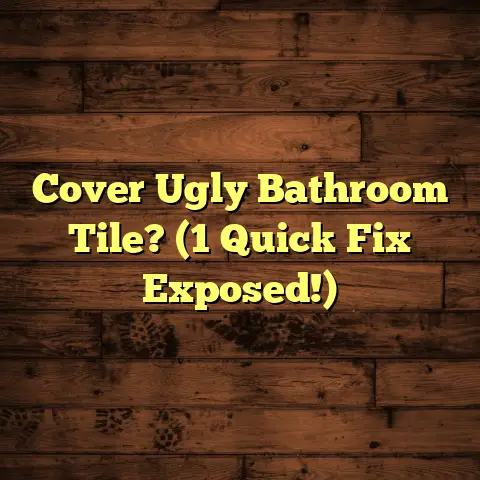Carpet or Hardwood: Which Is Healthier? (Toxic?)
(Image: A split image showing a vibrant, plush carpet on one side and a sleek, polished hardwood floor on the other.)
I’ve seen it all, from shag carpets older than me to the latest waterproof hardwood imitations.Today, let’s tackle a question I get asked all the time: Carpet or hardwood – which is healthier? And more importantly, are either of them toxic?
It’s a big question, right? We all want our homes to be safe havens, not sources of hidden health hazards. So, let’s dive deep into the world of flooring and uncover the truth.
Overview of Flooring Options
Flooring has been around for ages. Think back to simple dirt floors in caves. We’ve come a long way!
Carpet, in its early forms, was a luxury item, often hand-woven and incredibly expensive. Hardwood has been a staple for centuries, prized for its durability and beauty.
Now, what do I mean by “healthier” flooring? It’s more than just looks. We’re talking about:
- Indoor Air Quality: Does it release harmful chemicals?
- Allergens: Does it trap dust and pet dander?
- Toxins: Are there hidden dangers in the materials?
- Maintenance: How easy is it to keep clean?
- Comfort: Does it contribute to a healthy living environment?
Materials and Manufacturing Processes
Let’s get into the nitty-gritty. What are these floors actually made of?
Carpet Composition
Carpet’s come a long way from wool. Most modern carpets use synthetic fibers like:
- Nylon: Durable, stain-resistant, but petroleum-based.
- Polyester: Budget-friendly, good color retention, but less durable.
- Olefin (Polypropylene): Moisture-resistant, often used outdoors.
But it’s not just the fibers! Think about the carpet backing:
- Latex: Can be a source of allergens for some people.
- Polypropylene: A common, synthetic alternative.
And then there are the treatments… stain resistance, fire retardants. These often involve chemicals that can off-gas Volatile Organic Compounds (VOCs).
Hardwood Composition
Hardwood seems simpler, right? Wood is wood. Well, not exactly.
- Solid Hardwood: Made from a single piece of wood. Think oak, maple, cherry – the classics.
- Engineered Hardwood: Multiple layers of wood veneer glued together with a hardwood layer on top. It’s more stable in humid environments.
The glue in engineered hardwood can be a concern. It sometimes contains formaldehyde, a known carcinogen.
And what about the finish? Polyurethane is common. It protects the wood but can also release VOCs.
The Manufacturing Problem
Both carpet and hardwood can introduce toxins during manufacturing. VOCs are a big one. These are gases emitted from solids or liquids.
Formaldehyde is another. It’s used in adhesives and some finishes.
These chemicals can cause:
- Eye, nose, and throat irritation
- Headaches
- Nausea
- Respiratory problems
- Long-term health issues
Allergen and Dust Accumulation
Okay, let’s talk about dust bunnies!
Carpet: The Allergen Magnet?
Carpet does trap dust, pet dander, pollen, and other allergens. It acts like a giant filter. Good and bad, right?
The good news? It keeps those particles out of the air. The bad news? You have to remove them regularly.
If you don’t vacuum often, those allergens can build up and trigger allergies or asthma.
Studies have shown higher allergen levels in homes with carpet compared to hardwood, if the carpet isn’t properly maintained.
Hardwood: The Clean Sweep?
Hardwood is generally easier to clean. Dust and allergens sit on the surface, making them easy to sweep or mop away.
But, here’s the thing: Dust does become airborne more easily. So, you might be breathing in those allergens more readily.
The Verdict on Allergens
I always tell my clients: Regular cleaning is key, no matter what flooring you have.
Chemical Exposure and Toxins
Let’s get real about the potential dangers.
Carpet Chemicals: What Are We Dealing With?
New carpets can off-gas a variety of chemicals, including:
- VOCs: From dyes, adhesives, and stain treatments.
- Perfluorinated Chemicals (PFCs): Used for stain resistance. Some studies have linked PFCs to health problems.
- Flame Retardants: Some older carpets contained polybrominated diphenyl ethers (PBDEs), which have since been phased out due to health concerns.
Prolonged exposure to these chemicals can be risky, especially for children, the elderly, and people with respiratory issues.
Hardwood Finishes: Are They Safe?
The finishes and sealants used on hardwood can also contain VOCs.
- Oil-based polyurethane: Durable but high in VOCs.
- Water-based polyurethane: Lower in VOCs, but may not be as durable.
Formaldehyde, as mentioned before, can be present in the adhesives used in engineered hardwood.
Minimizing Chemical Exposure
Here’s my advice:
- Look for low-VOC or VOC-free products. Many manufacturers are now offering healthier options.
- Ventilate well during and after installation. Open windows and run fans to air out the space.
- Consider natural alternatives. For carpet, look for wool or other natural fibers. For hardwood, consider natural oil finishes.
Maintenance and Cleaning
Cleaning matters. A lot.
Carpet Cleaning: A Deep Dive
Carpet needs regular vacuuming to remove dust and allergens. I recommend vacuuming at least twice a week, more if you have pets or allergies.
Deep cleaning is also important. Steam cleaning or hot water extraction can remove embedded dirt and stains.
But… be careful with cleaning products! Many contain harsh chemicals that can irritate your skin and respiratory system.
Hardwood Cleaning: Keep It Simple
Hardwood is generally easier to clean. Sweeping or vacuuming regularly is usually enough.
For spills, wipe them up immediately to prevent staining.
When mopping, use a damp mop, not a soaking wet one. Excess water can damage the wood.
Avoid harsh chemicals. Look for pH-neutral cleaners specifically designed for hardwood floors.
Eco-Friendly Cleaning Options
I’m a big fan of eco-friendly cleaning. Here are some of my favorites:
- For Carpet: Baking soda can absorb odors. Vinegar can help remove stains. Look for plant-based carpet cleaners.
- For Hardwood: Vinegar and water solution. Castile soap. Avoid anything with harsh chemicals or abrasives.
Impact on Indoor Air Quality
This is where things get interesting.
Carpet and Air Quality
Carpet can act as a sink for pollutants, trapping them and preventing them from circulating in the air.
But, as we’ve discussed, those pollutants can be released back into the air if the carpet isn’t cleaned regularly.
New carpet can off-gas VOCs, which can negatively impact indoor air quality.
Hardwood and Air Quality
Hardwood doesn’t trap pollutants as much as carpet, but it also doesn’t filter the air.
Dust and allergens can become airborne more easily, potentially affecting air quality.
The finishes and adhesives used on hardwood can also release VOCs.
Humidity and Temperature
Humidity and temperature can also affect air quality.
High humidity can promote mold growth in carpet.
Extreme temperature fluctuations can cause hardwood to expand and contract, potentially releasing VOCs from the finish.
Expert Opinions
The EPA (Environmental Protection Agency) provides resources on indoor air quality and flooring.
[Link to EPA resources on indoor air quality]
Many experts recommend choosing low-VOC flooring options and maintaining good ventilation to improve indoor air quality.
Psychological and Emotional Aspects
Believe it or not, flooring can affect your mood!
Carpet: Warmth and Comfort
Carpet can create a sense of warmth and comfort. It’s soft underfoot, which can be especially appealing in bedrooms and living rooms.
The texture and color of carpet can also influence the overall feel of a space.
Hardwood: Cleanliness and Modernity
Hardwood can create a sense of cleanliness and modernity. It’s often associated with a more minimalist aesthetic.
The hard surface can feel cooler and more energizing.
How Flooring Affects Mood
Studies have shown that our environment can have a significant impact on our mood and stress levels.
The right flooring can create a more relaxing and inviting space.
Case Studies and Real-Life Examples
Okay, let’s hear from real people.
Homeowner Testimonials
“I switched from carpet to hardwood because my allergies were out of control. It made a huge difference!” – Sarah, Homeowner
“I love the cozy feel of carpet in my bedroom. It makes the space feel so much more inviting.” – John, Homeowner
“We chose engineered hardwood because it’s more durable and water-resistant than solid hardwood. We have kids and pets, so it’s been a great choice.” – Emily, Homeowner
Long-Term Health Outcomes
It’s difficult to directly link flooring choices to long-term health outcomes.
However, studies have shown that reducing exposure to VOCs and allergens can improve respiratory health and reduce allergy symptoms.
Conclusion
So, which is healthier, carpet or hardwood?
The truth is, there’s no easy answer. Both have pros and cons.
Carpet can trap allergens but also release VOCs. Hardwood is easier to clean but can also contribute to airborne allergens.
The best choice depends on your individual needs and priorities.
Consider these questions:
- Do you have allergies or asthma?
- Do you have children or pets?
- Are you sensitive to chemicals?
- What is your budget?
- How much time are you willing to spend on cleaning and maintenance?
Ultimately, the healthiest flooring is the one that you can maintain properly and that minimizes your exposure to harmful chemicals and allergens.





